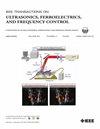集成开放式扫描仪和3072单元密集阵列的创新型超声研究平台。
IF 3.7
2区 工程技术
Q1 ACOUSTICS
IEEE transactions on ultrasonics, ferroelectrics, and frequency control
Pub Date : 2025-03-08
DOI:10.1109/TUFFC.2025.3568197
引用次数: 0
摘要
高端4-D超声成像系统通常使用基于包含数千个换能器的2-D阵列的探头。专用集成电路(asic)嵌入探针中,管理众多传感器,显著减少相关扫描仪所需的通道数量。不幸的是,这些高端系统的封闭架构阻碍了研究活动,例如对新成像方法的实验测试。本文介绍了一种新型的4-D超声成像研究平台的开发和应用,该平台结合了ULA-OP 256开放式扫描仪和成人4D Premium经食管探头,集成了一个矩形3072传感器阵列。描述了扫描仪上的硬件、软件和固件开发。通过比较模拟声场和实验声场在传输聚焦宽波束和平面发散波时的功能,证明了该系统的功能。后一种光束用于高帧率成像,表明该平台能够在任意平面上实时重建高达800帧/秒以上的图像。在体内,健康志愿者颈动脉的双平面b模式图像与动态多门光谱多普勒图像一起获得。这种新颖的平台独特地集成了高密度二维阵列的可编程开放式扫描仪的优点。通过实现创新的4-D成像和多普勒方法的实时评估,它有可能显著影响到目前使用含有有限数量元素的2-D探针进行测试的应用。本文章由计算机程序翻译,如有差异,请以英文原文为准。
An Innovative Ultrasound Research Platform Integrating an Open Scanner and a 3072-Element Dense Array
High-end 4-D ultrasound (US) imaging systems typically use probes based on 2-D arrays containing thousands of transducers. Application specific integrated circuits (ASICs), embedded in the probe, manage the numerous transducers, significantly reducing the number of channels needed for the associated scanner. Unfortunately, the closed architecture of these high-end systems prevents research activities, such as the experimental testing of new imaging methods. This article presents the development and application of a novel 4-D US imaging research platform that combines the ULA-OP 256 open scanner and the Adult 4-D Premium transesophageal probe, integrating a rectangular 3072-transducer array. The hardware, software, and firmware developments specifically made on the scanner are described. The functionality of the novel system is demonstrated by comparing simulated and experimental acoustic fields when transmitting focused wide beams (FWBs) and planar diverging waves (PDWs). The latter beams are exploited for high-frame-rate imaging, demonstrating the platform capable of reconstructing, in real time, up to over 800 frames/s over arbitrary planes. In vivo, bi-plane, B-mode images from the carotid artery of a healthy volunteer have been obtained together with dynamic multigate spectral Doppler (MSD) images. The novel platform uniquely integrates the benefits of a programmable open scanner with a high-density 2-D array. By enabling the real-time evaluation of innovative 4-D imaging and Doppler methods, it has the potential to significantly impact applications so far tested with 2-D probes containing a limited number of elements.
求助全文
通过发布文献求助,成功后即可免费获取论文全文。
去求助
来源期刊
CiteScore
7.70
自引率
16.70%
发文量
583
审稿时长
4.5 months
期刊介绍:
IEEE Transactions on Ultrasonics, Ferroelectrics and Frequency Control includes the theory, technology, materials, and applications relating to: (1) the generation, transmission, and detection of ultrasonic waves and related phenomena; (2) medical ultrasound, including hyperthermia, bioeffects, tissue characterization and imaging; (3) ferroelectric, piezoelectric, and piezomagnetic materials, including crystals, polycrystalline solids, films, polymers, and composites; (4) frequency control, timing and time distribution, including crystal oscillators and other means of classical frequency control, and atomic, molecular and laser frequency control standards. Areas of interest range from fundamental studies to the design and/or applications of devices and systems.

 求助内容:
求助内容: 应助结果提醒方式:
应助结果提醒方式:


